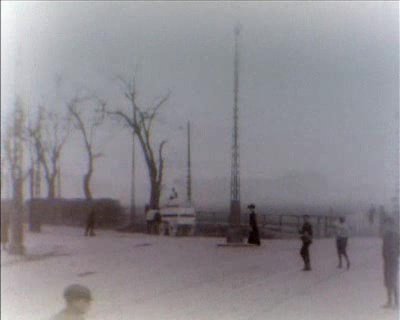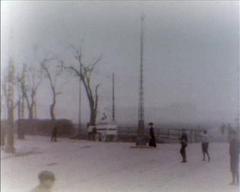
Trianglen Copenhagen: Visiting Hours, Tickets, and Historical Sites Guide
Date: 15/06/2025
Introduction
Nestled in Copenhagen’s lively Østerbro district, Trianglen (“The Triangle”) is a unique urban square where centuries of Danish history and modern city life intersect. This crossroads—formed by major avenues such as Østerbrogade, Blegdamsvej, and Øster Allé—has evolved from strategic military grounds and communal pastures into a bustling civic and transportation hub. Today, Trianglen is celebrated for its access to green spaces like Fælledparken, architectural icons such as the “Bien” tram pavilion, vibrant café culture, and easy access via the modern City Circle Metro Line (M3).
This guide offers a comprehensive overview of Trianglen’s history, cultural significance, practical visitor information, nearby attractions, accessibility, and insider tips—equipping you with everything you need to plan your visit to this dynamic corner of Copenhagen.
For deeper historical context and visitor resources, refer to the Museum of Copenhagen’s historical documentation, the Post Museum official website, and Copenhagen Metro Information.
Table of Contents
Historical Background
Origins and Strategic Importance
Trianglen’s distinct shape is a result of its location at the convergence of several key roads (KBH.dk). In the early 17th century, under King Christian IV, the area was part of Copenhagen’s outer defensive lines and served as communal grazing land (“fælleder”). The construction of a redoubt and the relocation of Vartov hospital in 1630 highlight Trianglen’s military and strategic value. Although the redoubt was destroyed during the Swedish siege (1658–1660), the area continued to serve as a militia training ground, as evidenced in 18th-century maps (Museum of Copenhagen, 2015).
Urbanization and Development
Due to the “demarkation line” restricting permanent stone buildings outside the city ramparts, Trianglen remained largely rural until 1856, when the restriction was lifted. This spurred the construction of residential buildings and initiated the area’s urban transformation (KBH.dk). The creation of Øster Allé in 1750 and Nordre Frihavnsgade in 1892 further established Trianglen as a prominent city node.
Transportation and Civic Role
By the 19th century, Trianglen emerged as a key transportation junction with the introduction of tram lines. The “Bien” pavilion (the Bee), designed by P.V. Jensen Klint in 1905, became a local landmark—serving as a ticket office, public restrooms, and a waiting area (Danish Wikipedia). Later, civic infrastructure like the Østre Elektricitetsværk and Østerbro Post Office (now the Post Museum) cemented Trianglen’s role as a community hub.
Fælledparken’s Preservation
Fælledparken, Copenhagen’s largest public park, lies adjacent to Trianglen. Originally common pastureland, it was preserved from development in the early 20th century and officially protected in 1965, thanks to local political efforts (Museum of Copenhagen, 2015). The park’s entrance at Trianglen features the “Genforeningsmonument,” commemorating the 1920 reunification of Southern Jutland with Denmark.
Archaeological Discoveries
During metro construction, archaeological digs unearthed artifacts such as an execution “breaking wheel” used between 1771 and 1811—shedding light on the area’s complex social history (Museum of Copenhagen, 2015).
Cultural Significance
Today, Trianglen is a vibrant social and cultural hub, close to historical sites like Sankt Jacobs Kirke and the Post Museum, and hosts community events, local markets, and festivals.
Visitor Information
Opening Hours
- Trianglen Square & Fælledparken: Open to the public 24/7.
- Post Museum: Tuesday–Sunday, 10:00 AM–5:00 PM; closed Mondays (Post Museum Official Site).
- Enigma Museum of Communication: Tuesday–Sunday, 11:00 AM–5:00 PM; closed Mondays (Enigma Museum).
Tickets and Admission
- Trianglen Square & Fælledparken: Free access.
- Post Museum & Enigma Museum: Admission fees apply; discounts for students, seniors, and children; under 18s enter free at Enigma. Tickets available at entrances and online.
Accessibility
Trianglen and its main attractions are wheelchair accessible. The Metro station features elevators and tactile guidance for visually impaired visitors. Public restrooms (in the “Bien” pavilion) are available during park hours.
Transport and Travel Tips
- Metro: Take the City Circle Line (M3) to Trianglen Station.
- Bus: Several lines serve the area.
- Bike: Extensive cycling lanes and city bike-share stations are nearby.
- Parking: Limited metered street parking; public transport is recommended (Copenhagen Metro Information).
Events and Guided Tours
- Fælledparken and Trianglen host seasonal events, outdoor concerts, and community markets.
- Local operators offer guided walking and cycling tours that include Trianglen and Østerbro.
Photographic Highlights
- The “Bien” tram pavilion—an architectural landmark.
- Genforeningsmonument at the entrance to Fælledparken.
- Panoramic views over Fælledparken and vibrant street scenes.
Nearby Attractions
- Fælledparken: Jogging trails, playgrounds, sports fields, and major events (VisitCopenhagen).
- Enigma Museum of Communication: Interactive exhibits on postal and digital communication (Enigma Museum).
- Parken Stadium: National football arena and concert venue.
- The Lakes (Søerne): Picturesque urban lakes ideal for walking and cycling (VisitDenmark).
- Rosenborg Castle & King’s Garden: Royal history and gardens within walking distance (VisitDenmark).
FAQs
Q: What are Trianglen’s opening hours?
A: The square and park are accessible 24/7. Museums nearby have specific opening hours.
Q: Is there an entrance fee to Trianglen or Fælledparken?
A: No, both are free public spaces.
Q: How do I get to Trianglen?
A: Use the M3 Cityringen Metro line or several bus routes. Biking is also convenient.
Q: Are there guided tours?
A: Yes, various local tour operators offer guided walks and bike tours featuring Trianglen and Østerbro.
Q: Is Trianglen accessible for people with disabilities?
A: Yes, the area and major attractions are designed for accessibility.
Practical Tips for Visitors
- Best Time to Visit: Spring and summer for outdoor events and pleasant weather.
- Language: Danish is spoken; English is widely understood.
- Payments: Credit/debit cards and mobile payments are standard.
- Safety: The area is safe and family-friendly; dial 112 for emergencies.
- Dining: Try local cafés for traditional Danish open-faced sandwiches (“smørrebrød”).
- Shopping: Independent boutiques and specialty shops line Østerbrogade and Nordre Frihavnsgade.
Summary and Visitor Recommendations
Trianglen exemplifies Copenhagen’s blend of historic depth and contemporary urban culture. Its unique triangular layout, proximity to Fælledparken, architectural landmarks like the “Bien” pavilion, and vibrant local scene make it a rewarding destination for both leisure and cultural exploration. Excellent public transit, accessibility, and a welcoming neighborhood atmosphere ensure a positive experience for all visitors.
For detailed planning and up-to-date information, consult the Visit Copenhagen tourism site, the Post Museum, and Copenhagen Metro Information. To enhance your stay, download the Audiala app for tailored city guides and real-time updates.
Sources and Further Reading
- Museum of Copenhagen—Historical Trianglen Documentation
- Post Museum Official Site
- KBH.dk Historical Blog on Trianglen
- Copenhagen Metro Information
- Visit Copenhagen Official Tourism Site
- Danish Wikipedia—Trianglen
- Danish Design Review—Trianglen
- Enigma Museum of Communication
- VisitDenmark—Copenhagen Attractions
- Join Life X—Østerbro Guide
- Rye115—Find Us
- Heritage Portal—Travel Tips
- Authentic Scandinavia—Best Things in Copenhagen
- Copenhagen.com—Visitor Information

























































































